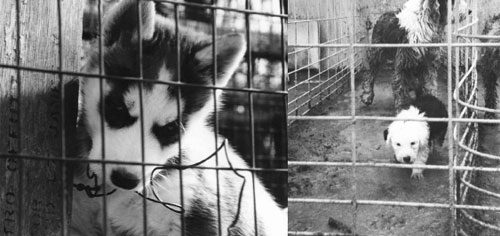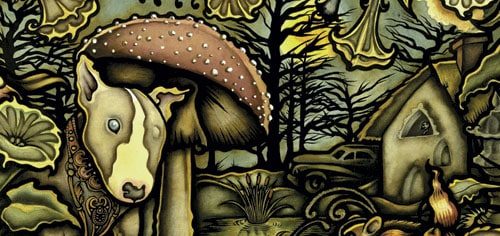

What Would You Do if Your City Banned Your Dog’s Breed?
The Heartbreak that is Breed Specific Legislation
The banning of breeds, confiscation of family dogs, and the business of changing public perception
I have a secret. It’s something that few people know about me, a dog fanatic that lives her life as an open book. I am scared of Pit Bulls. Terrified, actually. I am afraid to extend my arm, hand out, palm up, to a Pit Bull for fear of being attacked. And this is from a woman who greets every dog who comes her way with a “Hello baby” or “What a pretty dog.” For every breed but one, I will ask the owner, “Can I pat your dog?” and then gleefully rub the head of any pup whose owner permits it.
Except Pit Bulls.
This isn’t the result of some historic Pit Bull trauma. When I was in grade school, a Borzoi at the top of our street once lunged at me, tearing the collar of my coat. And as a child, visiting my grandpa, a pair of Pomeranians used to try to bite us kids through the fence. Neither breed scares me now. My sister had a Rottweiler and now has a Doberman, and I have no fear. I had German Wirehaired Pointers and currently have a large cross breed that is far more German Shepherd than Golden Retriever, and I have no fear. But I am afraid of Pit Bulls so I’ve kept my distance— and, until now, my secret.
Then, I received a chance invitation to the Vancouver premiere of the documentary Beyond the Myth: The Truth About Pit Bulls, a film dedicated to demonstrating that Pit Bulls are saddled with an undeserved reputation fueled by ignorance and misunderstanding. It heartrendingly illustrates the consequences of breed specific legislation (BSL). Imagine your dog confiscated by the authorities and put down simply because he is of a breed your city has legislated against. I RSVP’d in the affirmative. The viewing was a watershed moment. I realized I was guilty of buying into a myth. Somehow, somewhere, at some unknown point in time, I had allowed a notion to become a belief—one without a grain of evidence to support it. Fear has a way of doing that, insinuating itself though unsubstantiated. There are a lot of theories of how fear takes root. Certainly, in the case of Pit Bulls, there is a lot of blame on the media for reporting Pit Bull attacks differently than other dog bite incidents. If a Pit Bull is incriminated, the language employed is frequently more graphic and the breed is often only named (sometimes incorrectly) if it’s a Pit Bull.
But more scary than my fear of Pit Bulls is the fact that this fear is so widely shared that many cities and jurisdictions have acted on it, introducing BSL that can either impose conditions on bull-breed dogs or prohibit people from owning or keeping the dogs within the jurisdiction altogether. Like Ontario—a province so scared of Pit Bulls, it banned them altogether (with few grandfathering exceptions).
Think of it: your city empowered to outlaw your perfectly lovely, well-socialized dog simply because it is a member of a certain breed. BSL means a dog is considered vicious and then treated as such solely because of how it looks. It has nothing to do with past behaviour. It has nothing to do with current behaviour. It has nothing to do with the commission of an aggressive act. The basis for BSL rests solely on a collection of perceptions such as the size of the body, shape of the head, and length of the hair. In other words, it is guilt by association— you look like a guilty dog so you will be treated like a guilty dog.
That was the case in the City of Denver where officials passed BSL and began seizing and euthanizing any dog it identified as a Pit Bull. Beyond the Myth relates the heartbreaking story of Desiree Arnold, who still grieves the death of her dog Coco, picked up for the sole crime of being a Pit Bull. City rules gave Desiree seven days to request a hearing or Coco would be killed. She found a third party outside the City who agreed to provide a new home for Coco, and Desiree waived her right to a hearing, allowing Coco to be released to a new caregiver.
Ultimately, though, that arrangement fell through and Coco returned home, only to be picked up by animal control again after someone reported seeing her back in Desiree’s house. After five weeks of being kenneled behind a chain link fence without any natural light, where she would “scream bloody murder” every time Desiree visited then left, Coco was euthanized, her body returned to her owners in a garbage bag.
What makes this terrible story all the worse is that Coco’s death was for naught. BSL does nothing to diminish dog bites and attacks. It is costly to enforce and cannot be enforced consistently as it is based on a look not a reality.
“Knowing dogs, lots of Pit Bulls can be lovely, happy, friendly, kissy family dogs when they are raised and bred properly,” says Sarah Bull, the City of Coquitlam’s Bylaw and Animal Services Supervisor (her opinions are her own and do not represent the City). “Every decade seems to have a different breed that gets demonized. For Pit Bulls, it kind of stuck.”
Compounding matters is the confusion over what dogs actually fall into the Pit Bull camp. Most people who speak of Pit Bulls are actually referring more broadly of a group of dogs that have Pit Bull or bull-breed characteristics, including muscular bodies, broad chests, short coats, and pronounced heads and jaws and cheeks.
Profiling dogs as Pit Bulls is opening a can of worms, says Shelagh Begg, Director of the bull-breed advocacy, education, and rescue group Hugabull. There are only three recognized bull-breeds: the American Pit Bull Terrier, the American Staffordshire Terrier, and the Staffordshire Bull Terrier. “Everything else is a catchphrase or a mix thereof; all are based on a look not an actual breed,” Begg explains.
This is important when it comes to breed specific legislation. If you ban a breed you need to first define the breed, or else enforcement personnel are left wringing their hands trying to enforce the law with a “looks like a duck, quacks like a duck” assessment. Begg says studies show that shelter workers incorrectly indentify a dog’s breed just by looking at it more than 85 per cent of the time.
Knee-jerk reactions are not the basis for sage decisions and such is the case with BSL. Italy is a perfect example. It began banning specific breeds and, with new attacks implicating yet other breeds, (worth noting the bans already in place did not prevent bites), more breeds were added until Italy boasted BSL naming some 92 different dog breeds. Also of note is the fact that Italy has recently repealed breed specific legislation in favour of more general terminology that addresses the problem of irresponsible owners and proven vicious dogs. Begg says that there isn’t a single statistic to prove BSL works and in jurisdictions with BSL, dog bite statistics do not decrease. One of the reasons is that BSL doesn’t address vicious dogs; rather it addresses dogs that look like another vicious dog.
The City of Coquitlam, BC had BSL. Until October 2011, the three recognized bull breeds were automatically considered vicious dogs and were required to be muzzled, along with other restrictive criteria imposed on them.
Animal Services Supervisor Bull says, in her opinion, BSL doesn’t work as any breed of dog can display bad behaviour and can bite, and City resources and efforts are better spent educating owners, enforcing rules, and ticketing owners who fail to comply.
“Punish the deed not the breed,” says Bull. The City of Coquitlam came to the same conclusion. Some of the criteria were hard to enforce, plus enforcement efforts were devoted to ensuring “perfectly friendly” Pit Bulls were muzzled, Bull says.
Another problem with BSL is it acts to support and confirm people’s unfounded biases. “We’d had a lot of complaints because people were afraid of the look of a dog that had never tried to bite anything. A neighbour would call us to report a vicious dog next door and we would ask, “Can you tell us about its behaviour?” and they would respond that it did nothing wrong but that they had kids and there was a Pit Bull in the yard next door and everyone knows Pit Bulls are vicious.”
It took a few years, she says, looking at how the City could create a bylaw that would provide the tools to allow animal service officers to address problem dogs. The City went from a two-tier system (the dog was either a normal dog or a bull-breed dog and therefore vicious) to a three-tiered system outlining the approach for dealing with normal, aggressive, and vicious dogs, regardless of breed, based solely on exhibited behaviour.
“From an enforcement perspective, it’s the best way to have consistency,” Bull says. “Pit Bull owners across the board have given positive feedback. They feel like they are being more fairly treated.”
Coquitlam wasn’t alone in repealing ineffective and prejudicial BSL, says Hugabull’s Begg. Delta and Vancouver, BC, repealed their own BSL as did Edmonton, AB. Cincinnati, OH repealed BSL after living with it for nine years. But the question remains, why would any jurisdiction keep—or worse, introduce—BSL knowing it doesn’t address the problem? Why create a law that leaves us all vulnerable just because it wears a cloak of false protection?
“Because it’s easy to do,” says Begg. “It’s easy to enact. You write it on a piece of paper. It gives policy makers an easy out to address a problem. An incident happens and the media glom onto ‘Pit Bull versus Dog’ story and there’s a lot of hype. The community cries for a breed ban in response and the policy makers feel pressure. Besides, they see that other places have done it.”
Shattering entrenched irrational fears is neither fast nor easy work, but exposing them to the clear light of day is a good start. In the case of BSL, the documentary Beyond the Myth does just that, forcing an examination of mistaken beliefs and providing much-needed information to counter the myths and misperceptions surrounding this group of dogs.
I know personally that the first step to addressing a fear is to recognize it as unfounded. I also know I need to take Begg up on her offer to spend some time with one of her “very clownish, gregarious, goofy, and loving” Pit Bulls because, as she says, until we look at the root cause of our fear, nothing is going to change.
Join the newsletter and never miss out on dog content again!
"*" indicates required fields
By clicking the arrow, you agree to our web Terms of Use and Privacy & Cookie Policy. Easy unsubscribe links are provided in every email.





